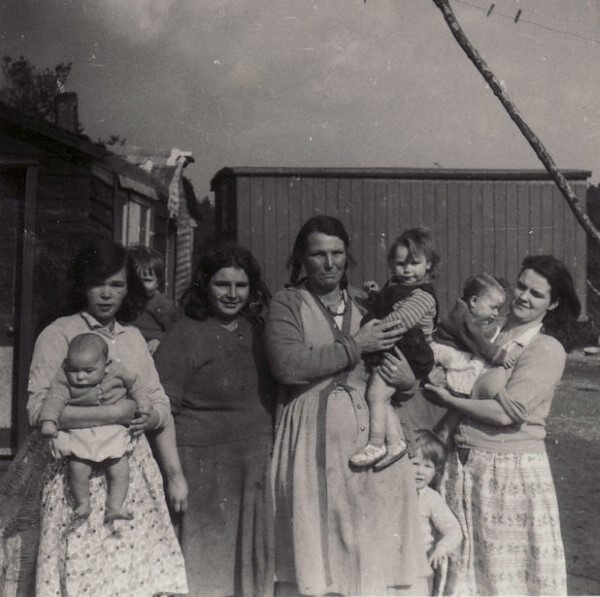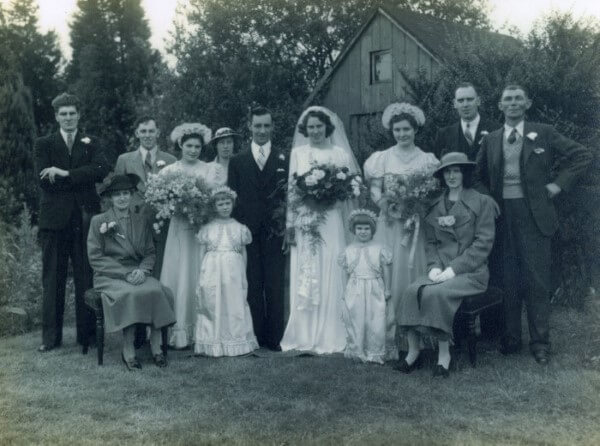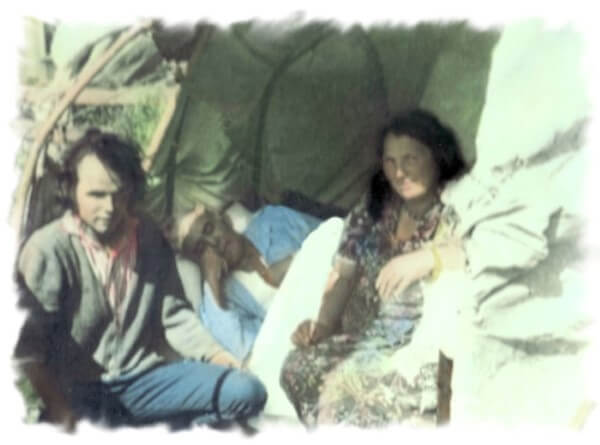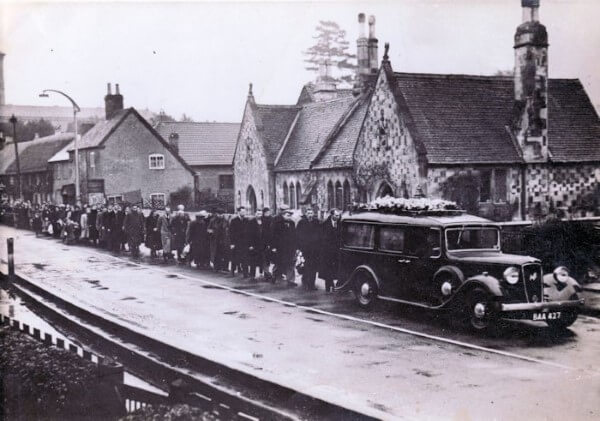Births, Deaths and Marriages
Birth
Many years ago the birth of a Gypsy baby had special customs. An individual tent was prepared for the new arrival and the men were not allowed near it. The woman was not able to prepare food for her family for a few weeks after the birth as she was believed to be mochadi (unclean).
After the birth the tent was burnt with all its contents. Gypsy babies have been known to be born in the New Forest by a special holly tree at Godshill near Fordingbridge or on a bed of straw. After the baby was born it was not to be touched by its father until it had been christened.
Since the 1950’s most Gypsy babies have been born in hospital with the father often waiting in the corridor whilst the mother gives birth with one or more female companions.

Caroline Hughes, Nellie Lamb, Eliza Hughes and Jean Hughes at Thorney Hill compound
Photo courtesy of Edward Cooper (84)
Marriage
Gypsies had very high morals and their young daughters were not allowed to spend time alone with young men. If a man asked to take out a girl they would have a chaperone for the evening. Boys and girls would meet each other on their site and spend evenings around the fire together with all the other family members or maybe they would meet whilst working potato, or hop picking. Sometimes a young man would give a girl he liked his diklo (scarf worn around his neck); if he saw the girl wearing it, he would know she liked him. If a young single girl still managed to get pregnant despite the high level of supervision she would have to marry as soon as possible.
Many Gypsies did not marry in a church and would instead have a ceremony called jumping the broomstick, a Romany wedding, or a simple ceremony of holding hands, which they considered to be binding; some couples would also have a ceremony at a local Registry Office.

Marriage at Dibden Purlieu 1939, group includes Amy Loveridge (nee. Lamb) seated far right, and her husband, Joseph (Joe)
the four bridesmaids are also Lambs. (59) Photo courtesy of Alan Grandy, Surrey
First the Groom to be would need to seek permission from the girl’s father and if this was granted a ceremony would be organised. A huge wedding feast would be prepared and the groom would buy himself a cooking pot and made a bender for him and his new wife to live in.
Jumping the broomstick
During the actual ceremony the couple would hold hands as they jumped together sometimes over a bed of flowering gorse.
Holding Hands
The ceremony of holding hands was when the couple held hands in front of their witnesses and pledged their love for one another. A loaf of bread was broken and the couples thumbs were both pricked allowing a drop of blood to fall onto each end of the bread which was then eaten by the couple and the rest of the bread was broken over their heads.
After the wedding, there were great celebrations with singing, dancing, drinking and the wedding feast.
Death
There are many Gypsy traditions and superstitions related to death and the burial of their loved ones. Because Gypsies are very family orientated many family members and friends from miles around will visit the person who is severely ill and the patient will never be left alone. It is traditional for a dying person to be allowed to die outside so it has been known for hospital patients to be wheeled outside for their last moments of life. Customarily candles are lit near the bed of the dying person to light the way to their afterlife.

This bender was built to enable a dying man to spend his last hours outside with his family nearby.
The photo includes William Hughes (Bill) and Eliza Hughes (103) Courtesy of Edward Cooper and Caroline Cooper
If the person died away from home it was customary to take the body home, if this was to a trailer the walls were hung with clean white sheets and decorated with fresh wild flowers.
Sometimes if a family were planning to travel for a long time they would be forced to lay their loved one to rest along the way. This was known as a Hedge Burial and these burials have been carried out all over the country and marked in such a way as to be found again only by the knowing.
Gypsies did not like to touch their own dead and often an outsider (Gorgio) was brought in to help prepare the body. The deceased person was dressed up in their best clothes and if it was a woman she would wear all her jewellery unless she had daughters to inherit them, money and valuables were often given away before the death. A vigil would be kept over the body until the burial.
The coffin would normally need to be considerably larger than the body as it would be buried with their possessions that would be useful in their afterlife such as their favourite musical instrument, knives, watches and money. Food was sometimes also included so that they had substance to last them on their long journey. It was very important that the deceased was sent comfortably on their journey.
Any remaining possessions of the deceased were burnt or buried including the wagon or bender, cooking pots and crockery. Horses or dogs were often slaughtered and any horse brasses or harnesses were destroyed. No possessions were supposed to be left to be used by the living in case the deceased soul came back to claim them. If the family were forced to sell any of the deceased’s belongings because they needed the money they would need to be sold outside of the family.
It is traditional to keep a small memento of the deceased to put away as a private memory or to give up something associated with the deceased such as something that they enjoyed eating and you would generally not tell anyone else what it was.
There would be a proper Christian burial which would be attended by many people, (sometimes hundreds) to pay their last respects, and distance would not be an obstacle. Funerals would always be elaborate and cost a fortune but all the family would try to contribute financially, these days a Gypsy funeral is no different.

A Gypsy/Traveller Funeral held in Wilton (75)
Photo courtesy of Edward Cooper
